NEW
Tales in general can be based around: based on observable truths;
can't be verified anymore due to altered circumstances; they were
invented for some reason; or they are modern constructs.
IMHO: In the environment of folklore, all of these are just as
valid.
This page tries to look at the tales that, before Newgrange's
reconstruction, sunligth was seen in its chamber.
At present days the sunlight is seen in the passage (photo of Ken WiIliams with kind
permission):
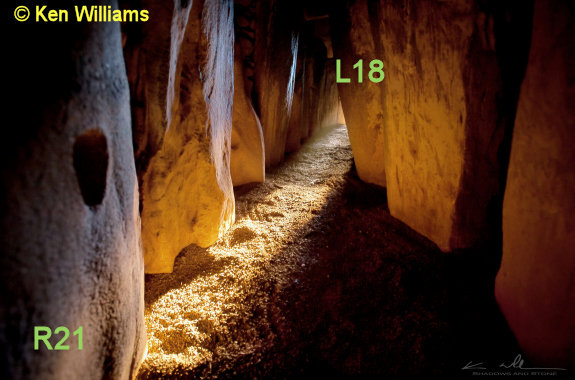
What would happen if the modern floor (dry gravel sand) was
replaced with wet mud with small puddles (looking from the chamber
to the entrance; R21 is on the left)?

A. Murphy [Do the myths about
Newgrange and the Boyne Valley mounds offer an insight into
their function?, 2016] interprets a text in the The Wooing of Étaín
[Anon1, from around 1100 to 1400, para. 20, 21, 25] as a reference
to light into Newgrange:
At last, however, a chance gust of wind blew her through a window of the fairy palace of Angus on the Boyne [assumed to be Newgrange]. The immortals cannot be hidden from each other, and Angus knew what she was. Unable to release her altogether from the spell of Fuamnach, he made a sunny bower for her, and planted round it all manner of choice and honey-laden flowers, on which she lived as long as she was with him, while in the secrecy of the night he restored her to her own form and enjoyed her love.
In 'A dream of Angus Oge'
(1897, page 130) of the Irish author, poet, and self-described
clairvoyant George William Russell wrote (well before the
excavations of O'Kelly):
It is very dark,' said the child [Con] disconsolately. He had expected something different. 'Nay, but look: you will see it is the palace of a god.' And even as he [a Shepherd of the Dananns] spoke a light began to glow and to pervade the [perhaps Newgrange?] cave and to obliterate the stone walls and the antique hieroglyphs engraved thereon, and to melt the earthen floor into itself like a fiery sun suddenly uprisen within the world, and there was everywhere a wandering ecstasy of sound: light and sound were one; light had a voice, and the music hung glistering in the air. [between square brackets are additions by Victor Reijs]Another tale of Russell around Brú na Bóinne and related to Sun rise ('The Celtic imagination', 1918, page 168):
In myself as in others I know they awakened ecstasy. To one who lay on the mound which is called the Brugh on the Boyne a form like that the bards speak of Angus appeared, and it cried: "Can you not see me? Can you not hear me? I come from the Land of Immortal Youth." And I, though I could not be certain of speech, found the wild words flying up to my brain interpreting my own vision of the god, and it seemed to be crying to me: "Oh, see our sun is dawning for us, ever dawning, with ever youthful and triumphant voices. Your sun is but a smoky shadow: ours the ruddy and eternal glow. Your fire is far away, but ours within our hearts is ever living and through wood and wave is ever dawning on adoring eyes. My birds from purple fiery plumage shed the light of lights. Their kisses wake the love that never dies and leads through death to me. My love shall be in thine when love is sacrifice."
As the thin line of light widened to a 17 cm-band and swung across the chamber floor, the tomb was dramatically illuminated and various details of the side and end recesses could be clearly seen in the light reflected from the floor.There exists a tale/myth [Anon3] around Newgrange (O'Kelly's, Newgrange, 1984, page 123):
[...] a belief existed in the neighbourhood that the rising sun, at some specified time, used to light up the three-spiral stone (C10) in the end recess. No one could be found who had witnessed this but it continued to be mentioned and we assumed that some confusion existed between Newgrange and the midsummer phenomenon at Stonehenge.Tony O'Riordan (The Irish Times, 4 February 1984) recalls that, during the war years (1940 - 1945), Mr. Hickey was adamant that the Sun entered the chamber:
While all of Mr Hickey's observations may not have agreed with modern archaeological opinion and knowledge, he was an entertaining and enthusiastic guide and he was adamant that at the time of the mid-winter solstice, the sun shone in through the narrow entry to the inner chamber.It is great to see that O'Kelly tried to find people who had witnessed this. Unluckily he was unsuccessful, but I found this article of Sonja Geoghegan [2003] on the Internet that tells that Sunlight was visible in the end recess:
My original lesson with the triple spiral at Newgrange came in 1959 on a cold Winter Solstice morning, by invitation of my grandfather. We entered the cairn in relative darkness and silently stood waiting for something that was unknown to me to begin. When the red warm light began to flood the darkness with its liquid gold, the movement toward me was captivating. I had been placed in a specific spot located directly across from the triple-spiral and it was there that I saw the light stop momentarily focused upon the symbol, with all the point marks that capture the light causing it to wink and sparkle with life similar to the stars in the night sky.A tale from Hugh Russell emerged in 2016 (L.E. Freeman Marr, The ritual origins of the roof-box at Newgrange, 2018, page 45):
...
My eldest son was conceived in the early spring of equinox and was born on winter solstice, as many generations before have guided. I took him into this cairn at Winter Solstice when he was young to show him what I had been given and he immediately understood without language as I watched this light & meaning fill him completely until he exclaimed to me, "This too is my legacy!"
My father was born in 1880, so therefore, he went back a long time. Now, when we would be farming on our farm, we could see the buses going to Newgrange, and he used to tell me that the light shone in on Solstice day. Bob Hickey and his wife they were the caretakers, he explained what Newgrange was and he didn’t tell us how long it was, when Newgrange was actually discovered, but he explained to us, and brought us in then, and he brought us into the cremation chamber there, and showed us that, and then told us about the light shining through on the shortest day of the year.
A former guide was in the chamber at Newgrange in the late 1950s. Being 12 or so and it was only during the summer time journeying from Dublin with the father. Recalling getting candles from Mrs Hickey and going inside. The light was very poor though and she remembers a dry passageway, no puddles or pooling water.That light can be seen around summer time, could be due to the reflections of the Sun shining on the backside of K1. K1's back can act as a lightsource towards the chamber through the passage. But also a bright blue sky with the Sun could provide this light into the chamber. This light would be fainter than reflected light (water or floor) and much fainter than light through the roofbox.
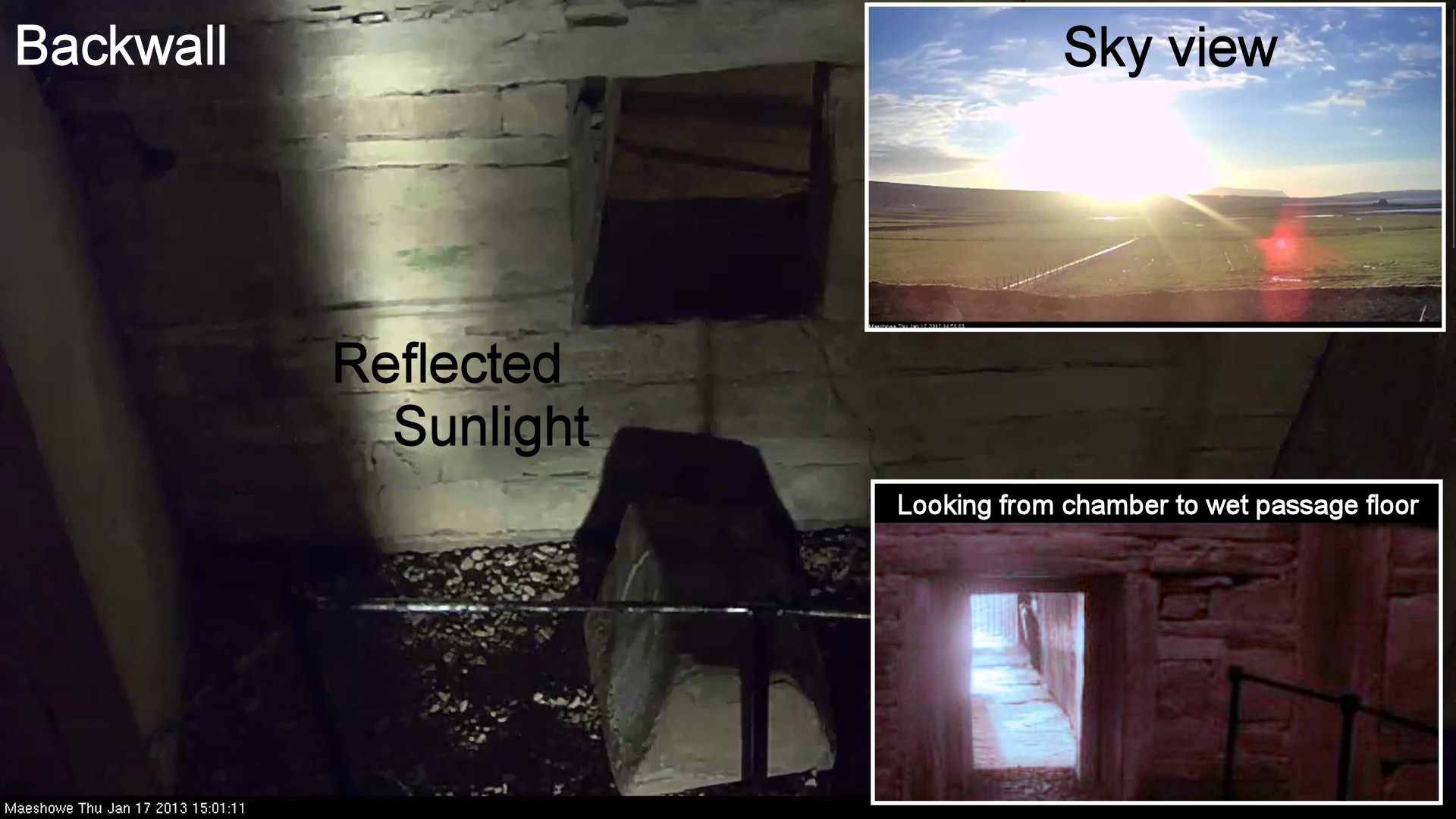
In winter-time a small stream of water formerly entered the passage between R7 and R8 and flowed through the entrance to escape between K1 and K2. Dr. H. G. Leask, a former Inspector of National Monuments, had installed a short-piped drain in an endeavour to draw off the water, but this had little success. When the passage orthostats were being straightened up it was found that the source of the water was a spring which welled up from the socket of R8. A piped drain was laid, running from this point under the centre of the passage floor and through the space between K1 and K2, to a stone-filled sink-hole at the edge of the excavated area. This expedient proved successful.It looks that H. G. Leask might have done this work between 1923 to 1949, as he worked for OPW in that time frame.
Even if we posit extremely early written sources for all of the versions, however, we are still left with an oral tradition spanning approximately four thousand years. Besides the sheer duration of this interval, we must reckon with the momentous cultural developments it included: the conversion of the Irish to Christianity and also, almost certainly, the arrival of Celtic language in Ireland.And according to him the present folklore is derived from the time the passage was obstructed due to its caving in somewhere before 2500 BCE, so some 4000 years old.
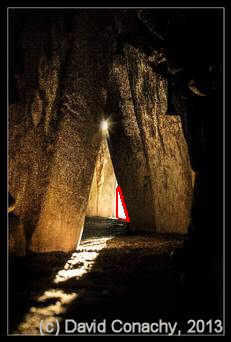
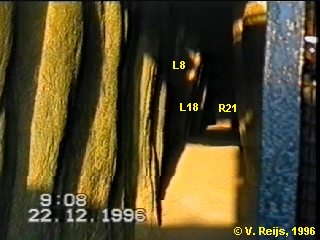
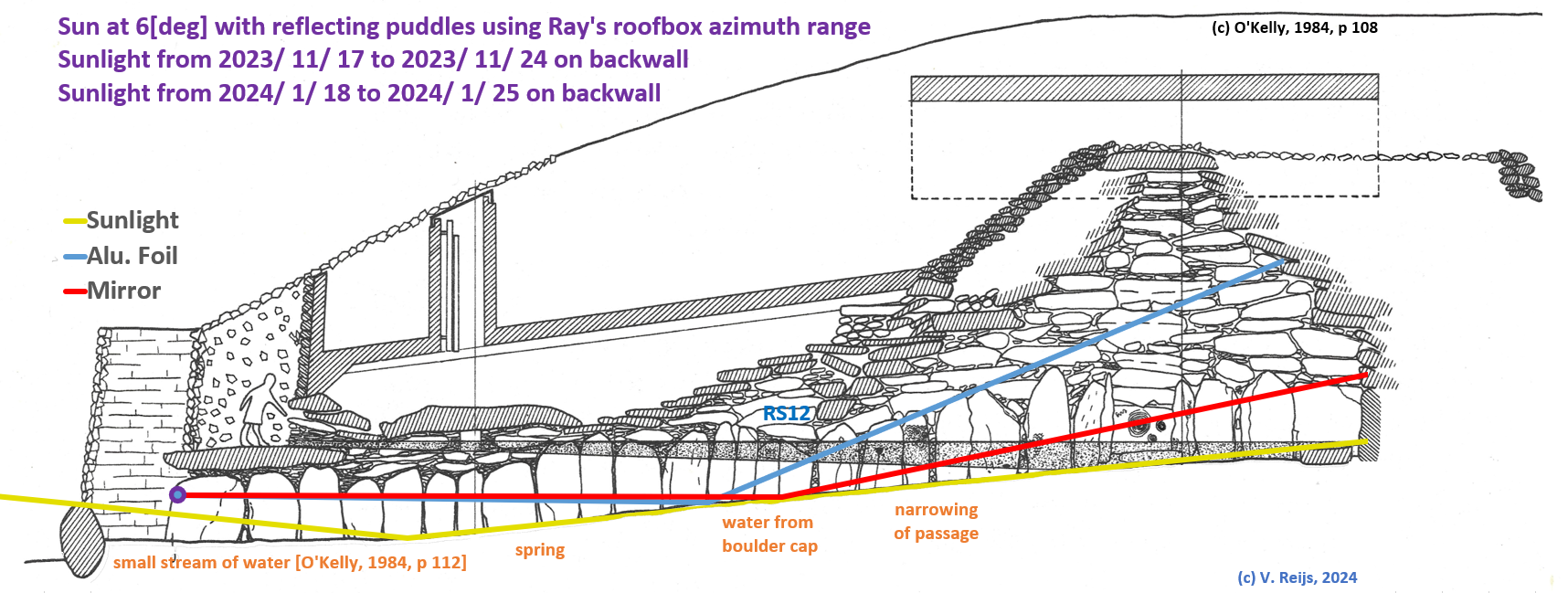
An excel model has been made of the passage, that allows for:
Propose to use first the Sun's azimuth range that could reach
the chamber (aka along all the passage orthostats) as
determined by Tom Ray [1989] for the roofbox: which azimuth
range is 133.8° to 137.5°.
<earlier, in O'Kelly [1984, page 124] J. Patrick is quoted
to have found: 133.7° to 138.5°>
Assuming the roofbox has the same width as the passage, the
passage will have a similar azimuth range (it might be
somewhat different). The Sun around winter solstice can reach
these azimuth through the roofbox when its centre is between
an apparent altitude of 0.9 and 2.7° (see here for the evaluation
of apparent altitude). The passage will have a different
sky window, so lets assume that the Sun's altitude can vary
between 0.9° (top rim of Sun at the apparent altitude of the
skyline) and say 11° (bottom rim of the Sun reaches RS12) to
reach above
the centre recess.
Assuming the above, one can determine at what time the
reflected sunlight will be on the backwall of the centre
recess.
The sunlight can be reflected over a wet floor or water
puddle. Remember that a wet floor is quite difficult
to define, so its effects need to be evaluated at
every observation.
| Example
of wet floor |
Example
of puddles |
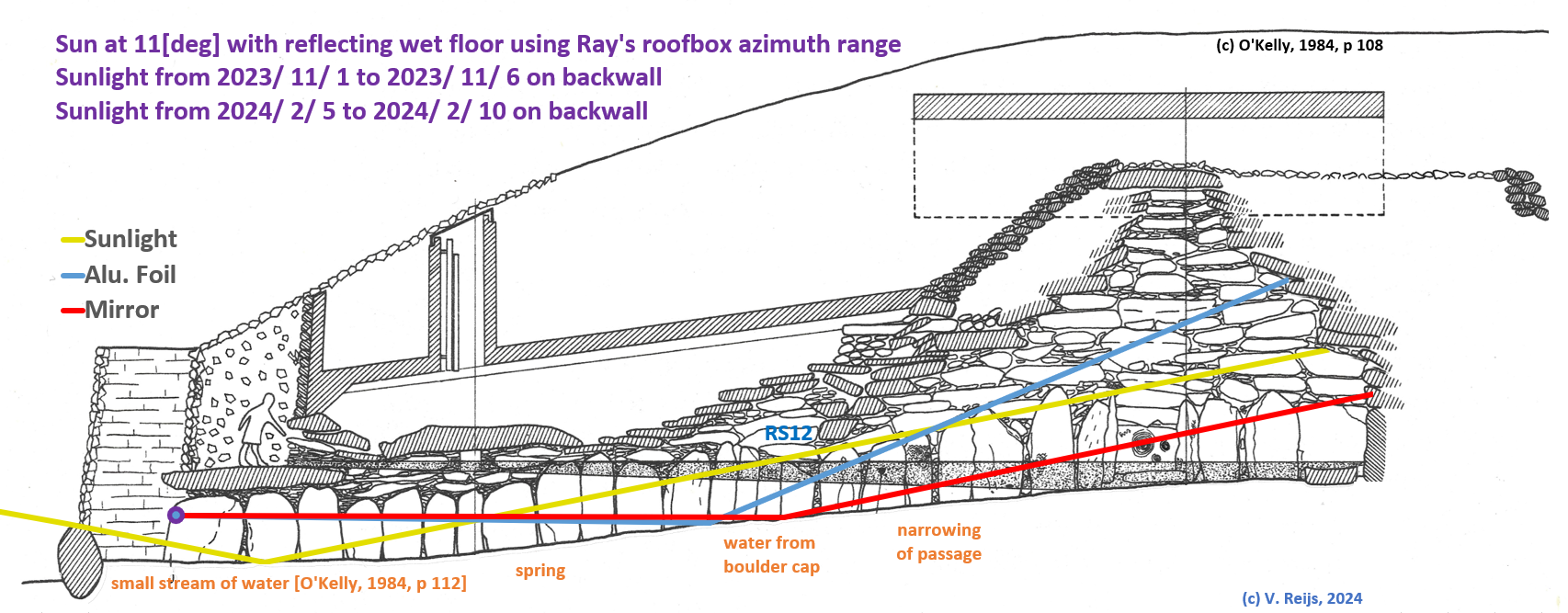 |
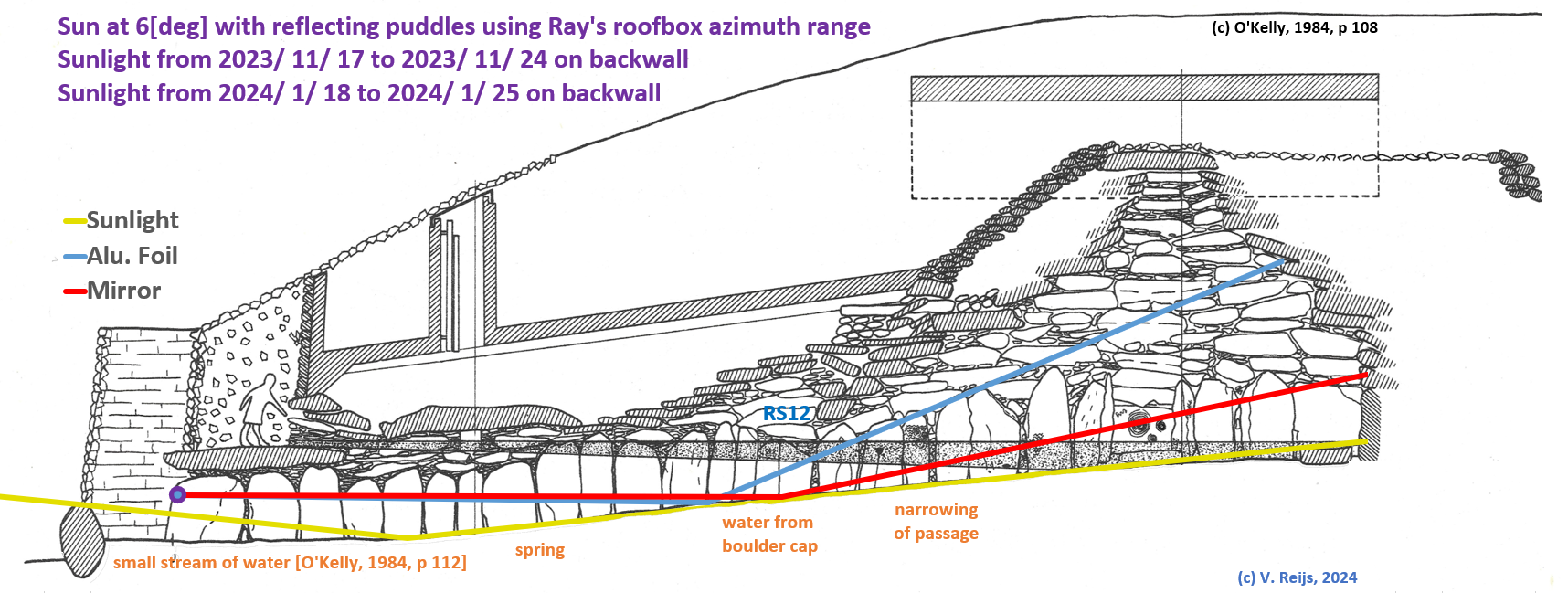 |
For illustration also the likely visibility of sunlight
through the roofbox on the chamber floor is presented (dotted
lines: utilising the data found by Prendergast [Winter
solstice phenomenon at Newgrange: Research report 2024, page
54] some minus to plus 19days of winter solstice visible on
the floor.
<At construction time this could be minus to
plus 24 days [Reijs, 2001] of winter solstice visible on
the floor [the time range is not fully known yet!]>
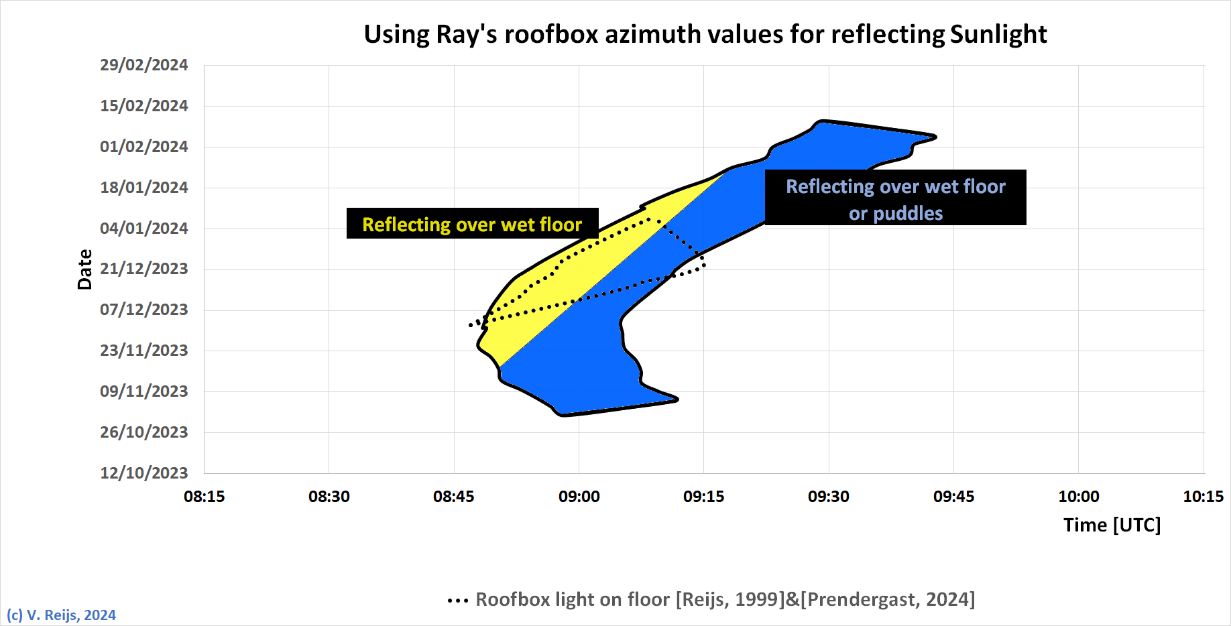
Instead of using the azimuth range as presented though Ray's roofbox, the
minimum and maximum azimuths were derived by looking at
unobstructed lines in the birdseye view of the passage
(exclude the roofbox).
The reflected artificial light could touch C10, with the three
double spirals, by the reflected beam over K1, just not
touching L4 and then over a reflective surface to the middle
of C10. The Sun though does not go South enough at such a low
apparent altitude.

The minimum (132.9°) and maximum (135.6°) azimuths are
incoported in below skywindow picture (assuming
that the reference line in O'Kelly's pictures is at 134.7°
by using Ray's True North direction). This range looks smaller
(25%) than Ray's
azimuth range of the roofbox.
In below picture both Reijs' and Ray's azimuth ranges have
been used:
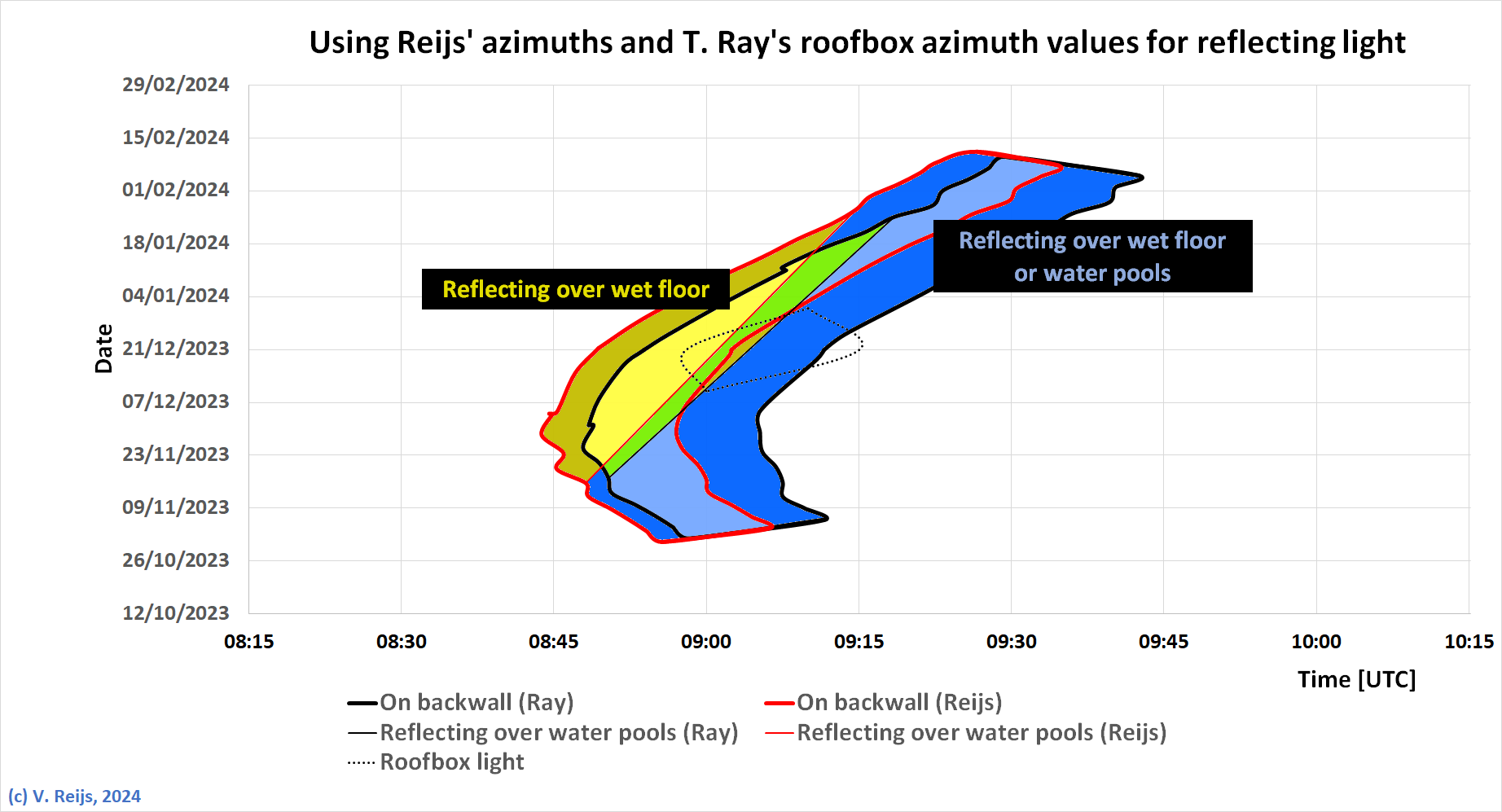
A more detailed check of the 3D effects is underway. Anyway
it is expected that a reflected sun is not able to reach the
surface of C10 during the construction or present epoch of
Newgrange.
More precise testing/thinking might be needed to predict/simulate things better;-)
My research started to see if the tale about light inside the
chamber before the 1962 could be proven (so before the
excavations and reconstruction of Newgrange). And IMHO this
proof can be provided through the use of water or wet
surfaces; which likely have existed in the pre-reconstructure
passage (water spring and leaky passage roof). This is based
on experiments done in 2015.
During the course of this research the question popped up: Can
we proof that these tales themselves are genuine?
Perhaps the answer to this last question is not important;
what is important is that light could be seen in the central
recess of Newgrange due to wet conditions in the winter
months.
I though don't think that the folklore has survived some 4000 years as Carey states; more some 200 or 100 years. The phenomenon can still be observed (at least before the excavations in 1962), which kept the folklore live.
As the passage and chamber are dry since ducting away the well water and building a concrete dome as part of the reconstruction. So, instead of natural water/wetness, use: aluminium foil (as done earlier); large-bubble foil (filled with 'puddles'); spray the floor with plenty of water (if llowed); and/or other means that can support further testing.
To have an oppertunity to photograph this phenomenon in situ
would be great.